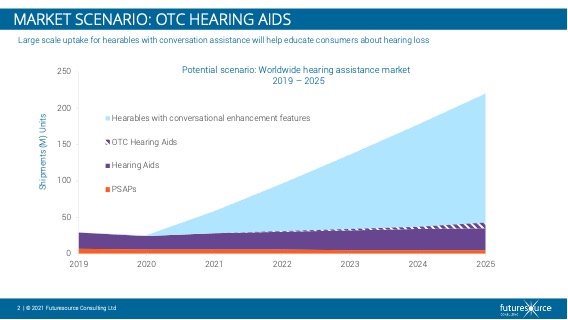Consumer demand for headphones has evolved significantly over the past few years. Continued technology advancement and lifestyle choices are extending existing use-cases, as well as developing new ones. As a result, such products must become more ergonomic, allowing for longer wearing times whilst becoming more intuitive to better understand varying environments and applications. This very topic was recently discussed at Futuresource’s Audio Collaborative event which took place last month, the sessions of which can be viewed here.
Healthy Market Growth and Brand Choice Amongst Consumers
The overall headphones market is set to grow at a healthy 15% through 2025, with use-cases beyond music becoming well-established. Growth in the true wireless (TWS) space remains significant and now represents over 50% of all new headphones sales. Work from home, online education, fitness and gaming emerged as important use cases during the pandemic and are set to retain their relevance in the long term. Apple is the category leader and commands close to a quarter of this segment. According to Futuresource’s Audio Tech Lifestyles consumer research, two thirds of consumers prefer to purchase the same brand of TWS as their smartphones, owing to the seamless user interface and ecosystem experience; a trend also benefitting Samsung and Xiaomi’s performance in the category.
Industry moves towards Improved Listening
A top trend in the headphones and hearables convergence continues to be the pursuit of ever higher quality audio improving the listening experience for consumers. This will entail bringing in better quality audio, not restricted to music listening alone. The rising non-music-based functionality of headphones is sparking increased focus on ‘Zoom fatigue’ reduction and the way in which improved audio quality can aid this. This also becomes imperative as hearables are used for ever longer periods of time throughout the day and night. Sound quality transcends beyond hearables and is perhaps more relevant to hearing aids users. Beyond just helping consumers listen to sounds, users also need to be able to hear better in more challenging environments, such as in a noisy restaurant or on public transport.
What Key Features will Start to Develop?
The development of all-in-one SOCs from chipset vendors has already aided in the incorporation of features such as voice assistants and ANC in sub $100 devices. The addition of ANC continues to rise in popularity and accounted close to a third of all TWS shipments from Q1-Q3 2021. The scope to integrate biometric sensors and conversational enhancement technology improves the usability and opportunity presented by the wider hearables segment. However, feature development is a tradeoff between battery consumption and the consumer need that the headset vendor is looking to satisfy, with the ultimate goal to enhance user experience.
Hearing health is clearly a space with immense monetization opportunities that ecosystem giants will look to develop with the measurable insights derived from all the tracking data and offering associated health-based services.
As this trend towards audio convergence continues to unfold, the next practical step is the production of Bluetooth low energy devices and with it, reduced sized batteries and subsequently smaller devices, in turn enhancing wearer comfort level for longer periods of time.
The Next Generation of Products
The health advantages that will come from the advancements being made in the headset industries provides a whole host of new opportunities. Headsets that can monitor brain activity and heart rate will enable science fiction to become reality.
For these devices to transition from concept to reality, the increase of computational power will be key. More computational and processing power will mean users have the power to define what good sound and bad sound is, and to personalise their own audio for the optimal listening experience.



